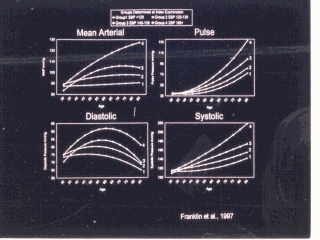 |
As a person ages, a number of characteristic changes occur in
the blood pressure. Systolic blood pressure rises with age, while changes in diastolic
blood pressure are much more complex. At a younger age, a rise in diastolic pressure is
seen, which is less steep than that of systolic pressure. However, from the age of around
50, diastolic pressure levels off and then begins to fall. Thus pulse pressure rises with
age, particularly steeply after middle age.These findings have been carefully documented
in longitudinal data from the Framingham Study, which has also shown that the rise in
systolic and in pulse pressure is most marked in subjects who have the highest levels of
blood pressure at the first examination. These changes in pressure are produced by vessel
stiffness. As the vessel ages, elastin content of the aortic wall thins and fragments,
eventually producing fracturing. With this comes an increase in deposition of collagen and
calcium. The increased rigidity of the aortic wall leads to greater resistance to systolic
expansion, with a more rapid rise in systolic pressure. The fall in diastolic pressure
from middle age is partly the result of the reduction in elastic recoil and partly the
consequence of increased systolic pressure causing more flow into the periphery in
systole. There is, however, another important contribution to the rise in pulse pressure
with age that relates to the reflected wave. |
